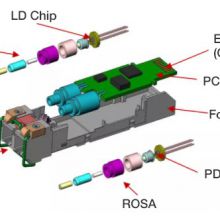
1. Introduction of optical moduleAs an important part of fiber optic communication, optical module is an optoelectronic device that realizes the function of photoelectric conversion and electro-optical conversion. To be precise, optical module is the general name of several types of modules, including optical transmitting module transmitter, optical receiving module receiver, optical transceiver module transmitter and optical forwarding module transmitter. Generally, the optical module we call generally refers to the integrated optical transceiver module, namely, optical transceiver. ① Working principle of optical transceiver Optical transceiver works in the physical layer of OSI model and is one of the core devices in optical fiber communication system. It is mainly composed of optoelectronic devices (optical transmitter, optical receiver), functional circuit and optical (Electrical) interface. Components of an optical transceiver Basic principle: the transmitting interface inputs an electrical signal with a certain code rate. After being processed by the internal driving chip, the driving semiconductor laser (LD) or light emitting diode (LED) emits a modulated optical signal with a corresponding rate. After being transmitted through the optical fiber, the receiving interface converts the optical signal from the optical detection diode into an electrical signal, After passing through the preamplifier, the electrical signal of the corresponding code rate is output. ② Key parameters of optical transceiver The key technical indicators of the optical transceiver mainly include: transmitting optical power, receiving optical power, overload optical power, maximum receiving sensitivity and extinction ratio. A. Transmitting optical power: refers to the optical power output by the light source at the transmitting end of the optical module under normal working conditions, which can be understood as the intensity of light, and the unit is w or MW or DBM. Where w or MW is the linear unit and DBM is the logarithmic unit. In communication, we usually use DBM to represent optical power, and the optical power of 0dbm corresponds to 1MW.B. Receiving optical power: refers to the average optical power range that can be received by the receiving end component under the condition of a certain bit error rate (BER = 10-12). The upper limit value is the overload optical power, and the lower limit value is the maximum value of reception sensitivity.C. Overload optical power: also known as saturated optical power, it refers to the maximum input average optical power that can be received by the receiver component when a certain bit error rate (BER = 10-12) is maintained at a certain transmission rate (unit: DBM). It should be noted that the photocurrent saturation of the photodetector will occur under strong light irradiation. Therefore, strong light irradiation should be avoided as far as possible to prevent exceeding the saturated light power.D. Receiving sensitivity: refers to the minimum average input optical power that can be received by the receiving end component when a certain bit error rate (BER = 10-12) is maintained at a certain transmission rate (unit: DBM). Generally, the higher the rate, the worse the reception sensitivity, that is, the greater the minimum received optical power, and the higher the requirements for the receiving devices of the optical transceiver.E. Extinction ratio (EXT): it is one of the important parameters used to measure the quality of optical modules. It refers to the ratio of the optical power P1 (when the laser emits all "1" codes) to P0 (when the laser emits all "0" codes) under the condition of full modulation, and the unit is dB. It is not that the greater the extinction ratio, the better the quality of the optical module, but that the optical module with an extinction ratio can meet the IEEE 802.3 standard is the better. ③ Example of optical transceiver information on the switch: Cisco switch interface optical transceiver information: Huawei switch interface optical transceiver information:2. Classification and packaging(form-factor) of optical transceivers ① Transmission rate: The current common types of optical modules are as follows:400GE optical module200GE optical module100GE optical module40GE optical module25GE Optical Module10GE Optical ModuleGE Optical ModuleFE Optical Module ② Form-factors: The higher the transmission rate, the more complex the structure, resulting in form-factors. For example, SFP/eSFP, SFP+, SFP28, QSFP+, CXP, CFP, QSFP28, etc. l SFP (Small Form-factor Pluggable) optical module: small pluggable SFP module supports LC fiber connector.l SFP + (Small Form-factor Pluggable plus) optical module: refers to the SFP module with increased rate. Because of the increased rate, it is sensitive to EMI and smaller than the SFP module.l XFP (10GB Small Form-factor Pluggable) optical module: "X" is the abbreviation of Roman numeral 10. All XFP modules are 10GE optical modules. The XFP optical module supports LC optical fiber connectors. Compared with SFP + optical module, XFP optical module is wider and longer in size.l SFP28 (Small Form-factor Pluggable 28) optical module: the interface package size is the same as that of SFP +, and supports 25G SFP28 optical module and 10G SFP + optical module.l QSFP+ (Quad Small Form-factor Pluggable) optical module: four channel small hot pluggable optical module. QSFP + optical module supports MPO optical fiber connector, which is larger than SFP + optical module. Fiber Mall 40G QSFP+ Optical Transceivers l CXP (120 GB/s Extended Capability Form-factor Pluggable) optical module: it is a hot-pluggable high-density parallel optical module standard. It provides 12 channels in the transmit and receive (TX / Rx) directions. It is only applicable to short-range multimode links.l CFP (CENTUM Form-factor pluggable) optical module: the size is defined as 144.75mm × 82mm × 13.6mm, which is a new optical module standard with high speed, hot-pluggable and supporting two applications of data communication and telecommunication transmission.l QSFP28 (Quad Small Form-factor Pluggable 28) optical module: the interface package size is the same as QSFP+, and supports 100G QSFP28 optical module and 40G QSFP+ optical module. ③ Single-mode or muti-mode? The optical fiber is divided into single-mode optical fiber and multi-mode optical fiber. The single-mode optical module is used together with the single-mode optical fiber. The single-mode optical fiber has wide transmission frequency bandwidth and large transmission capacity, which is suitable for long-distance transmission; The multi-mode optical module is used together with multi-mode optical fiber, and multi-mode optical fiber has mode dispersion defect, and its transmission performance is worse than that of single-mode optical fiber, but the cost is low. Therefore, it is suitable for small capacity and short-distance transmission. ④ Wavelength The central wavelength refers to the waveband used for optical signal transmission. At present, there are three kinds of common central wavelengths: 850nm, 1310nm and 1550nm.850nm: mostly used for short distance transmission (≤ 2km)1310nm and 1550nm: mostly used for medium and long distance transmission (>2km) ⑤ Transmission distance According to the different transmission distance of optical module, it can be divided into:Short distance optical module: ≤ 2kmMedium distance optical module, 10 ~ 20kmLong distance optical module: ≥30km.The transmission distance of optical modules is limited mainly because of the loss and dispersion of optical signals during fiber transmission. ⑥ Photoelectric module The photoelectric module is usually called electric port module or RJ45 SFP module. Unlike the optical module, the electric port module does not carry out photoelectric conversion. Through the switching of the electric module, the two optical interfaces can be connected with a network cable.RJ45 Copper SFP Module 3. Development and evolution of optical transceiversIn the current physical architecture network of mainstream data centers, Spine-Leaf (Clos network architecture) architecture is commonly followed. Usually 10GE interface is used as the access side server docking, and 40GE interface is commonly used for the uplink on the Leaf side. In large data centers, it has been common to use 25G as the mainstream access and 100G uplink. In scenarios requiring high computation and high bandwidth, GPU servers have been using 100GE and even 200GE access. Data center switch interconnects are evolving to large-scale 400GE interconnects.The development of Ethernet has undergone rapid changes from 1Mbit/s, 10Mbit/s, 100Mbit/s (FE), 1Gbit/s (GE), 10Gbit/s (10GE) to 40Gbit/s (40GE), 100Gbit\s (100GE), and with the rapid development of big data, smart cities, mobile Internet, cloud computing, network traffic has shown exponential growth. The thirst for continuous growth of bandwidth will require higher bandwidth rates, and optical modules will develop rapidly.
Fiber Optic Transceivers Optical Module Fiber Optic 2987 81 07/29/21RECENT POSTS
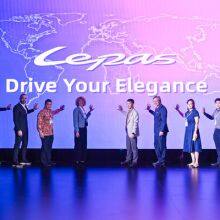
WUHU, China, Oct. 21, 2025 /PRNewswire/ -- On October 17, at the 2025 Chery International User Summit, LEPAS marked two key milestones the launch of its first LEPAS Elegant Lifestyle House and the global debut of LEPAS Elegant Technology, reinforcing its positioning as the "Preferred Brand for Elegant Mobility Life". LEPAS Opens Its First Elegant Lifestyle House, Globally Launches LEPAS Elegant Technology Designed as a miniature urban block, the LEPAS Elegant Lifestyle House breaks the mold of traditional auto showrooms. It houses three themed zones LEPAS Space (featuring flagship model LEPAS L8), Time Café (showcasing LEPAS L6), and Memory Lane (displaying LEPAS L4). Serving as a multifunctional hub for brand livestreams, user engagement activities and media interactions, it also provides a replicable model for global dealerships and supports user co-creation. From car, neighborhood to lifestyle philosophy, LEPAS redefines mobility and living boundaries in the new energy era. LEPAS Elegant Lifestyle House is more than an exhibition—it's a living vision, inviting elegant explorers to find their unique elegance here. LEPAS CEO Zhai Xiaobing emphasized that LEPAS is an independent new-energy brand developed by Chery Group leveraging its core resources. LEPAS Elegant Technology integrates a forward-engineered platform, advanced three-electric technologies and an intelligent cockpit to define "Elegant Driving". In the next three years, LEPAS will launch 8 new models, including SUVs and Sedans, covering all major segments. Notably, Chery's Ecosystem Exhibition at the summit featured lifestyle products such as sunshades and pet kits. Meanwhile, Chery's AiMOGA robot acting as a "Human Assistant" demonstrated multi-scenario applications jointly highlighting Chery Group's integrated innovation alongside eco-partners like LEPAS.
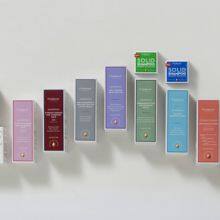
SHANGHAI, Oct. 21, 2025 /PRNewswire/ -- China's leading multi-brand beauty group JOY GROUP (Shanghai Juyi Cosmetics Co., Ltd.) has announced the completion of its acquisition of Foltène, a dermatological hair care brand from Italy. Products of Foltène Founded in Milan in 1944 by pharmaceutical researchers, Foltène is renowned for its scientific heritage and pioneering innovation. The brand developed two proprietary active complexes, Tricosaccaride® and Tricalgoxyl®, which are clinically proven to promote thicker, fuller, and healthier-looking hair. Foltène's core product portfolio focuses on the healthy growth and repair of hair and keratin, covering a wide range of categories including anti-hair loss ampoules, gender-specific anti-hair loss shampoos, eyebrow and eyelash serums, and nail repair essences. Backed by rigorous scientific research and clinical trials, Foltène's products are recognized by leading research institutions worldwide. Today, the brand is sold in 30+ countries, trusted and loved by consumers globally. This acquisition represents a full global acquisition of Foltène's brand business, covering its brand assets, global distribution network, supply chain system, and research laboratory located in Italy. Allan Liu, Chairman and CEO of JOY GROUP, stated: "As awareness of scalp and hair health continues to rise, we see immense growth opportunities ahead. With its solid scientific heritage, leading proprietary technologies, and comprehensive product portfolio, Foltène has earned the trust and recognition of consumers across the globe. We are truly honored to welcome Foltène into the JOY GROUP family. This acquisition enhances our footprint in the hair and scalp care sector and enables us to bring advanced, science-backed solutions to more consumers." This acquisition marks another milestone in JOY GROUP's "multi-brand, multi-category, and international" strategy, completing a comprehensive portfolio that spans color cosmetics, hair and scalp care, and dermatological skincare. The addition of Foltène will generate strong synergies with the Group's existing brands, driving JOY GROUP's continued growth and innovation in the global beauty market. About JOY GROUP JOY GROUP is a multi-brand beauty company driven by the mission to "Create a world of beauty that brings joy to everyone." Our portfolio includes: JUDYDOLL, JOOCYEE, Biophyto genesis, René Furterer (China business), and Foltène, spanning color cosmetics, dermatological skincare, and hair and scalp care. We also operate our own R&I center and cosmetics manufacturing facility, bringing together top talent across disciplines to build an integrated, agile, and responsive end-to-end supply chain. To learn more about JOY GROUP, visit www.joy-group.com
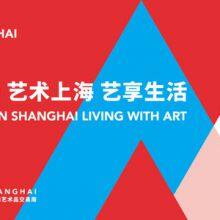
7th Shanghai International Artwork Trade Week Set to Open SHANGHAI, Oct. 21, 2025 /PRNewswire/ -- Grab a coffee, take a stroll — and you might just find yourself surrounded by art. From November 13 to 17, 2025, the 7th Shanghai International Artwork Trade Week will return under the theme "Global Art in Shanghai • Living with Art." This year's edition will feature over a hundred art events, including fairs, auctions, and gallery showcases, illuminating four of Shanghai's most iconic districts: the Bund, West Bund, Suhe Bay, and Pudong. In conjunction with the city's Art Season and Arts Festival, the week will also debut new initiatives including the Art Consumption Hub, a city-wide art-lifestyle experience space designed to bring art into everyday encounters; the ARTRA immersive cross-disciplinary arts program that bridges visual and performing arts; and the Magnolia Select curated art tours highlighting premium art destinations across the city. Drawing on global art resources and deepening the synergy across culture, tourism, commerce, and exhibitions, the event aims to further Shanghai's ambition to become a world-class art trading center with a market volume approaching hundreds of billions of yuan.
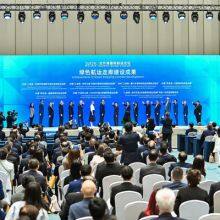
BEIJING, Oct. 21, 2025 /PRNewswire/ -- When 2025 North Bund Forum opened Sunday, Shanghai caught much attention from global attendees with its endeavors to build more green shipping corridors with overseas partners. Currently, the green shipping corridors built together with several European and American ports are advancing intensive application of emission-reduction technologies and multiple-party participation to establish a testing field for global shipping industry transformation. For instance, Shanghai port is co-founding a green ro-ro shipping corridor together with port of Barcelona in Spain and port of Antwerp-Bruges in Belgium. Other Chinese ports are building similar green shipping corridors with German and French ports. After a year-long operation, the "Shanghai-Hamburg green shipping corridor" unveiled in 2024, has forged ahead in sustainable development. Apart from the regular shore power service, Shanghai port's container berths can now refuel LNG and green methanol, while Hamburg port's berths with 100 percent green shore power service plans to start methanol injection service this year, ready to co-craft an emission-reduction model for Eurasian shipping routes. Between ports of Shanghai and Hamburg, two regular shipping lines that meet requirements of the IMO carbon intensity indicator have been operated by COSCO Shipping Lines to proactively practice low-carbon shipping. Against the backdrop of increasingly trending low-carbon development philosophy, more upstream and downstream institutions joined construction of the green shipping corridor, including Det Norske Veritas, China Classification Society, and Maritime Technology Cooperation Center, Asia. Prior to the corridor, another one between Shanghai port and ports of Los Angeles and Long Beach that kicked off in 2022 made new progress in the past year, including 100-percent shore power coverage, deployment of ships with full life-circle low-carbon emission and more injection services of clean marine fuels. At the forum, an international green shipping corridor cooperation initiative was released, proposing to foster low-carbon vessel development, build zero-carbon ports, improve green fuel supply and share related best practices to jointly establish the "transoceanic zero-carbon bridges". Shanghai Municipal Transportation Commission and the operator of Melbourne port also issued a joint green shipping corridor initiative, vowing to focus on decarbonization transformation and ecology friendly practices such as use of clean technology and renewable resources to maximumly cut the ecological footprint of shipping activities. Original link: https://en.imsilkroad.com/p/347958.html


